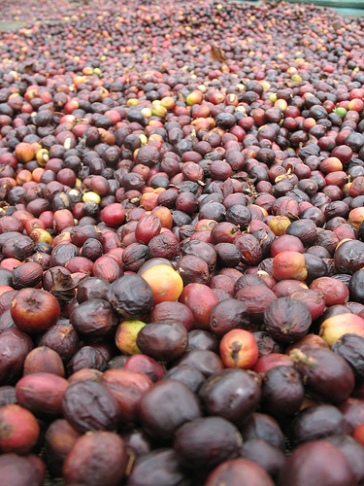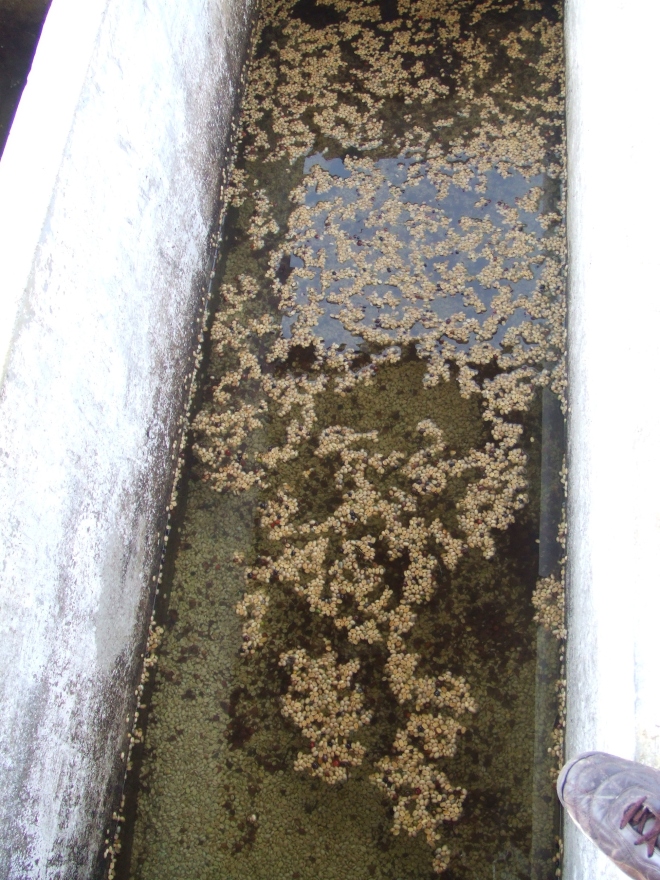To process green coffee to the stage ready for roasting, it needs to be fermented to remove all the mucilage from the bean. Mucilage is the sticky, fruity part which is between the skin and bean, it is a little like grape, but only a very thin layer between bean and skin.
Coffee is generally either processed ‘natural / sun dried’, or ‘washed’. For washed coffee, once the cherry has been picked from the tree, within 6 hours it needs to be pulped to remove the skin, and soaked in water to ferment. In that first 24 hours the mucilage is disolved, it then needs to be dried in the sun for between 5- 9 days to reduce moisture levels to between 10.5 – 11.5% which means it can safely sit for a year ready for roasting.
In countries where water is short, or for reasons which natural coffee is wanted, coffee is not water fermented, but dried in the sun in the cherry form. Once the cherry is picked from the tree, it is put straight onto raised beds to dry in the sun as a cherry, this may also take a week to dry.
Washed coffee is often dried on concrete patios, but natural coffee is usually dried on raised beds to allow air flow under beans.
Part of the water processing is floating the cherries in water, the good sink and the under / over ripe cherries, and sticks etc all float and are scooped off and discarded. This process removes a lot of defects, so washed coffee will inherently have a lower defect count then natural coffees, putting washed coffee in a higher quality level.
Once the coffee is washed, there is a lot of water which has all sorts of contaminants left in it from the coffee, which poison rivers, killing marine life due to changes in ph level etc.
Research and industry development has produced methods of cleaning the water which can be done at local processing plants with manageable installation costs. Small processing plants may be build by co-ops throughout the region of their farmers, to reduce work for farmers, give better control over quality through access to proper machinery, and to reduce their environmental impacts. These processing plants may have water cleaning facilities depending on the size.
Water treatment method used by PRODECOOP in Nicaragua:
3 steps are used here to process the water: physically, chemically and biologically.
Physically: Once the coffee is washed it is removed from the water, and the water is put in tank 1 for a while to allow large particles to settle, the top of the water is then drained to tank 2 leaving the ‘scum’. Water left in tank 1 evaporates under the clear roof , and the dry muck is scooped out and used as organic compost.
Chemically: next Calcium hydroxide is used which further separate sediment from good water, and is separated again.
Biologically: finally the water is pumped to run down a rough ramp with jagged stones protruding, this agitates the water creating turbulence and mixing water with oxygen. The water is cycled over the ramp more than once to finish the cleaning, and ph levels are acceptable, it is then reused or put back into river.
Pollution of rivers is a big problem in coffee producing areas, as many different coffee farmers spread for miles will be reusing the same river water as it runs down the mountain. Co-ops can play a key role in increasing production efficiencies and best practice as they hold a collective responsibility on behalf of locals, and have resources to build processing and water cleaning stations.
Another good reason to buy from co-ops.




